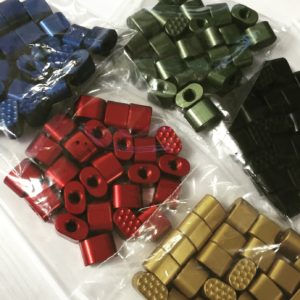 –Coating Description — Type II can be done at room temperature (20 °C 68 °F) with sulfuric acid at 10-20 volts. Depending the specific type aluminum being coated and the time it is processed determines the thickness. This can produce an anodizing thickness from about .0001″ to .0008″ thickness, where the natural oxide layers are generally 2 to 3 nanometers thick. Although its original finish is “white” that can be problematic due to the highly porous surface of type II, this gives it the capability of being able to be dyed virtually any color desired. These coatings can be dyed in a wide spectrum of colors. Typically, these are organic dyes that easily absorbed by the oxide layer. Then it undergoes a sealant process locking in the desired dye of choice.
–Coating Description — Type II can be done at room temperature (20 °C 68 °F) with sulfuric acid at 10-20 volts. Depending the specific type aluminum being coated and the time it is processed determines the thickness. This can produce an anodizing thickness from about .0001″ to .0008″ thickness, where the natural oxide layers are generally 2 to 3 nanometers thick. Although its original finish is “white” that can be problematic due to the highly porous surface of type II, this gives it the capability of being able to be dyed virtually any color desired. These coatings can be dyed in a wide spectrum of colors. Typically, these are organic dyes that easily absorbed by the oxide layer. Then it undergoes a sealant process locking in the desired dye of choice.
–Process Description — a protective oxide layer by an electrolytic process in which the metal forms the anode coating. Anodizing involves placing aluminum into a chemical acid bath charged with a DC current. The aluminum becomes the positive anode (which the term “anodizing” originates) of a chemical battery and the acid bath becomes the negative. The DC electric current passing through the acid causes the release of hydrogen at the negative electrode (cathode) and oxygen at the surface of the aluminum object creates a buildup of aluminum oxide. This oxidation forms a strong coating as it replaces the original aluminum surface. The typical anodizing process is multi step, and includes pretreatment steps before anodizing and post-treatments sealing and dying it after.
